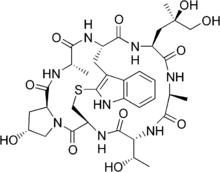Phallotoxin
The phallotoxins consist of at least seven compounds, all of which are bicyclic heptapeptides (seven amino acids), isolated from the death cap mushroom (Amanita phalloides).
Phalloidin had been isolated in 1937 by Feodor Lynen, Heinrich Wieland's student and son-in-law, and Ulrich Wieland of the University of Munich.[1][2] The remaining six are prophalloin, phalloin, phallisin, phallacidin, phallacin and phallisacin. Though highly toxic to liver cells, phallotoxins have since been found to have little contribution to the death cap's toxicity because they are not absorbed through the gut. Furthermore, phalloidin is also found in the edible (and sought after) Blusher (Amanita rubescens).[3]
Chemical structures
-

Phalloidin
-

Prophalloin
-

Phalloin
-

Phallisin
-

Phallacidin
-

Phallacin
-

Phallisacin
See also
- Amatoxins, a closely related class of mycotoxins
References
- ↑ Theodor Wieland (1987). "50 Jahre Phalloidin". Naturwissenschaften. 74 (8): 367–373. doi:10.1007/BF00405464. PMID 3309681.
- ↑ Feodor Lynen, Ulrich Wieland (1938). "Über die Giftstoffe des Knollenblätterpilzes". Justus Liebig's Annalen der Chemie. 533 (1): 93–117. doi:10.1002/jlac.19385330105.
- ↑ Litten, W. (March 1975). "The most poisonous mushrooms". Scientific American. 232 (3): 90–101. doi:10.1038/scientificamerican0375-90. PMID 1114308.
